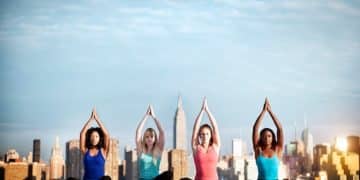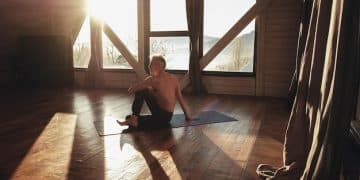Yoga for Runners: A 20-Minute Post-Run Routine to Prevent Injuries
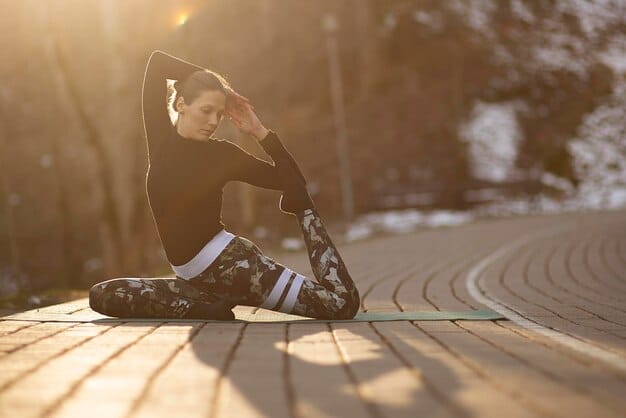
Yoga for runners offers a potent 20-minute post-run routine to mitigate injuries by enhancing flexibility, bolstering strength, and fostering mental equilibrium.
Running is a fantastic way to stay fit, but it can also take a toll on your body. Tight muscles and overuse injuries are common complaints among runners. Luckily, incorporating yoga for runners into your post-run routine can significantly reduce your risk of injury. A simple 20-minute yoga sequence can improve flexibility, build strength, and promote recovery, helping you stay on the road or trails longer.
Why Yoga is Beneficial for Runners
Many runners primarily focus on logging miles, often neglecting the importance of flexibility and recovery. This imbalance can lead to tight hamstrings, hip flexors, and calves, increasing the likelihood of injuries. Yoga offers a balanced approach, addressing both strength and flexibility.
Increased Flexibility
Running can cause muscles to tighten, restricting your range of motion. Yoga helps to lengthen and stretch these muscles, improving flexibility and reducing stiffness. This increased flexibility allows for more efficient movement and can prevent injuries.
Improved Strength
While running primarily works the lower body, yoga engages and strengthens the entire body, including core muscles. A strong core is essential for maintaining good posture and stability while running, reducing strain on the lower back and knees.
Enhanced Body Awareness
Yoga encourages you to pay attention to your body and how it moves. This increased body awareness can help you identify areas of tension or imbalances, allowing you to address them before they lead to injuries. By being more in tune with your body, you can adjust your running form and prevent overuse issues.
- Reduces muscle tightness and stiffness.
- Strengthens core and improves stability.
- Enhances awareness of body mechanics.
- Promotes relaxation and mental well-being.
Incorporating yoga into your routine is not just about physical benefits; it also offers mental advantages. The focus on breathwork and mindfulness can reduce stress and improve focus, crucial for both running performance and overall well-being. By combining physical and mental disciplines, yoga becomes a powerful tool for runners looking to stay healthy and perform their best.
The 20-Minute Post-Run Yoga Routine
This routine is designed to be a quick and effective way to stretch and strengthen the muscles most used in running. It’s perfect for after a run, when your muscles are warm and receptive to stretching. Remember to listen to your body and modify any poses as needed.
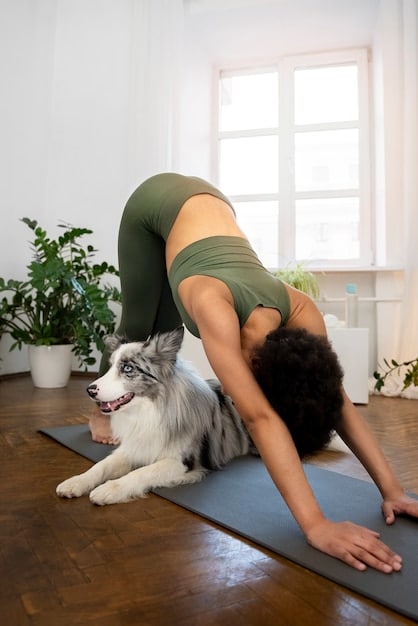
Downward-Facing Dog (Adho Mukha Svanasana)
Start on your hands and knees. Tuck your toes and lift your hips up and back, forming an inverted V-shape with your body. Press firmly into your hands and feet, lengthening your spine. Hold for 5-10 breaths.
Low Lunge (Anjaneyasana)
From Downward-Facing Dog, step your right foot forward between your hands. Ensure your right knee is aligned over your right ankle. Lower your left knee to the ground. Inhale and lift your chest, lengthening your spine. Hold for 5 breaths, then repeat on the other side.
By focusing on proper alignment and controlled movements, you can maximize the benefits of each pose and minimize the risk of injury. Regular practice of this 20-minute sequence can lead to significant improvements in flexibility, strength, and overall running performance.
Essential Yoga Poses for Injury Prevention
Certain yoga poses are particularly beneficial for runners due to their ability to target common areas of tightness and weakness. These poses can help prevent injuries by improving flexibility, strengthening key muscles, and promoting overall balance.
Hamstring Stretch (Uttanasana Variation)
Tight hamstrings are a common problem for runners. Stand with your feet hip-width apart and gently bend forward from your hips, keeping your back as straight as possible. Reach for your toes or shins. If you can’t reach, bend your knees slightly. Hold for 5-10 breaths.
Hip Flexor Stretch (Kneeling Hip Flexor Stretch)
Kneel on your right knee with your left foot forward, knee over ankle. Gently push your hips forward, feeling a stretch in the front of your right hip. Reach your right arm overhead for a deeper stretch. Hold for 5 breaths, then repeat on the other side.
Calf Stretch (Standing Calf Stretch)
Stand facing a wall, placing your hands on the wall at shoulder height. Step one foot back, keeping your heel on the ground. Lean into the wall, feeling a stretch in your calf. Hold for 5 breaths, then repeat on the other side.
- Uttanasana: Lengthens hamstrings
- Kneeling Hip Flexor Stretch: Improves hip mobility
- Standing Calf Stretch: Prevents Achilles issues
These poses help to counteract the repetitive motions of running, addressing the specific areas that are prone to tightness and injury. Regular incorporation of these stretches can lead to increased flexibility, reduced muscle imbalances, and a decreased risk of overuse injuries. Remember to focus on proper form and listen to your body to avoid overstretching.
Modifications and Variations for Different Levels
Yoga is adaptable to all levels of fitness. If you’re new to yoga or have certain limitations, there are several modifications you can make to ensure you’re getting the most out of your practice without risking injury.
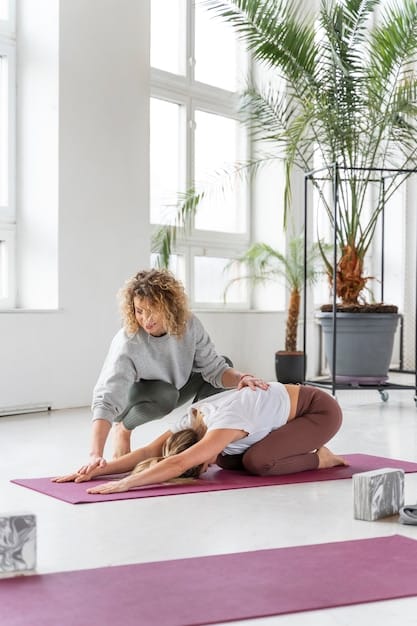
Beginner Modifications
If you’re new to yoga, start slowly and focus on proper alignment. In Downward-Facing Dog, you can bend your knees slightly to reduce pressure on your hamstrings. In Low Lunge, you can place a blanket under your back knee for support.
Advanced Variations
For more experienced yogis, you can deepen the stretches by adding variations. In Downward-Facing Dog, you can lift one leg towards the ceiling for a deeper hamstring stretch. In Low Lunge, you can twist your torso towards your front knee for a greater hip stretch.
Listening to Your Body
The most important thing is to listen to your body and modify the poses as needed. If you feel any pain, back off and adjust your position. Yoga is about finding balance and ease in your body, not pushing yourself to the limit.
By understanding your body’s limitations and adapting the poses accordingly, you can enjoy the benefits of yoga regardless of your experience level. This personalized approach ensures that the practice remains safe and effective, allowing you to progress gradually and avoid potential injuries. Remember, consistency is key, so aim to practice regularly, even if it’s just for a few minutes each day.
Breathing Techniques for Enhanced Recovery
Breathwork, or pranayama, is an integral part of yoga and can significantly enhance your recovery after a run. Different breathing techniques can help calm your nervous system, reduce stress, and promote relaxation, all of which are essential for muscle recovery.
Diaphragmatic Breathing (Belly Breathing)
Lie on your back with your knees bent and feet flat on the floor. Place one hand on your chest and the other on your belly. Inhale deeply through your nose, allowing your belly to rise while keeping your chest still. Exhale slowly through your mouth, allowing your belly to fall. Practice for 5-10 minutes.
Alternate Nostril Breathing (Nadi Shodhana)
Sit comfortably with your spine straight. Close your right nostril with your right thumb and inhale slowly through your left nostril. Then, close your left nostril with your right ring finger and release your right nostril, exhaling slowly through it. Inhale through your right nostril, close it, and exhale through your left nostril. Continue alternating nostrils for 5-10 minutes.
By incorporating these breathing techniques into your post-run routine, you can improve your body’s ability to recover and rejuvenate. This not only reduces the risk of injury but also enhances your overall running performance by promoting relaxation and mental clarity.
Integrating Yoga into Your Training Schedule
Consistency is key when it comes to reaping the benefits of yoga. Integrating it into your regular training schedule can help you maintain flexibility, strength, and overall well-being. Aim to practice yoga at least a few times a week, ideally after your runs.
Creating a Routine
Start by identifying a specific time each week when you can dedicate 20-30 minutes to yoga. This could be immediately after your run or later in the day. Make it a non-negotiable part of your schedule, just like your running workouts.
Listening to Your Body
On days when you feel particularly sore or fatigued, opt for a gentler yoga practice that focuses on stretching and relaxation. On days when you feel more energetic, you can incorporate more challenging poses and variations.
By making yoga a regular part of your training routine, you’ll not only reduce your risk of injury but also improve your overall running performance and enjoyment. The combination of physical and mental benefits makes yoga a valuable asset for any runner looking to stay healthy and achieve their goals.
| Key Benefit | Brief Description |
|---|---|
| 💪 Strength Building | Yoga strengthens core and supporting muscles. |
| 🧘 Flexibility Boost | Improves flexibility in tight areas like hamstrings. |
| 🤕 Injury Prevention | Reduces risk of common running injuries. |
| 😌 Stress Reduction | Promotes relaxation and reduces stress. |
Frequently Asked Questions
▼
Ideally, runners should incorporate yoga into their routine 2-3 times per week to see the most benefits in terms of flexibility and injury prevention.
▼
Poses like Downward-Facing Dog, Low Lunge, and hamstring stretches are particularly beneficial for runners as they target common areas of tightness.
▼
Yes, yoga can help with runner’s knee by strengthening the muscles around the knee joint and improving flexibility in the surrounding tissues.
▼
It’s generally better to do yoga after running, as your muscles are already warm and more receptive to stretching. Light yoga can be done before runs as well.
▼
No, you don’t need special equipment to do yoga. A yoga mat can be helpful for comfort and grip, but it’s not essential. Just wear comfortable clothing.
Conclusion
Incorporating a 20-minute post-run **yoga for runners** routine can be a game-changer for injury prevention and overall running performance. By focusing on flexibility, strength, and mindful breathing, you can keep your body healthy and on the road longer. Give it a try and experience the difference yourself!

